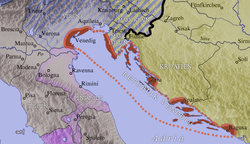Republik Venesia
bekas negara di Eropa Selatan
Republik Venesia (bahasa Italia: Repubblica di Venezia, bahasa Venesia: Repùblica Vèneta atau Repùblica de Venesia) adalah negara yang berpusat di daerah Venesia di Italia timur-laut. Negara ini berdiri selama satu milenium, dari akhir abad ke-7 hingga tahun 1797. Negeri ini juga dikenal dengan julukan La Serenissima. Republik Venesia pada masa kejayaannya adalah kekuatan maritim dan perdagangan utama di wilayah Mediterania.
Republik Venesia | |||||||||||||
|---|---|---|---|---|---|---|---|---|---|---|---|---|---|
| 697–1797 | |||||||||||||
Lagu kebangsaan: Juditha triumphans (1716 - 1797) | |||||||||||||
 Peta Republik Venesia tahun 1000an | |||||||||||||
 Perbatasan Venesia tahun 1796; Kepulauan Ionia tidak digambarkan | |||||||||||||
| Ibu kota | Eraclea (697–810) Venesia (810–1797) | ||||||||||||
| Bahasa yang umum digunakan | Venesia, Latin | ||||||||||||
| Pemerintahan | Republik Aristo-Plutokratik | ||||||||||||
| Doge (Adipati) | |||||||||||||
• 697–717 | Paolo Lucio Anafesto | ||||||||||||
• 726–37 | Orso Ipato | ||||||||||||
• 1789–97 | Ludovico Manin | ||||||||||||
| Sejarah | |||||||||||||
• Pendirian | 697 | ||||||||||||
• Ikut serta dalam Perang Salib IV | October 1202 | ||||||||||||
| 27 Juni 1358 | |||||||||||||
| 17 April 1797 | |||||||||||||
• Menyerah kepada Prancis | 12 Mei 1797 1797 | ||||||||||||
| 17 Oktober 1797 | |||||||||||||
| Mata uang | Lira Venesia | ||||||||||||
| |||||||||||||
Bacaan lanjutan
- Contarini, Gasparo (1599). The Commonwealth and Government of Venice. Lewes Lewkenor, translator. London: "Imprinted by I. Windet for E. Mattes". The most important contemporary account of Venice's governance during the time of its blossoming; numerous reprint editions; online facsimile[pranala nonaktif permanen].
- Benvenuti, Gino (1989). Le repubbliche marinare. Rome: Newton Compton.
- Brown, Patricia Fortini (2004). Private Lives in Renaissance Venice: art, architecture, and the family.
- Chambers, D. S. (1970). The Imperial Age of Venice, 1380–1580. London: Thames & Hudson. The best brief introduction in English, still completely reliable.
- Drechsler, Wolfgang (2002). Venice Misappropriated. Trames 6(2):192–201. A scathing review of Martin & Romano 2000; also a good summary on the most recent economic and political thought on Venice.
- Garrett, Martin (2006). Venice: a Cultural History. Revised edition of Venice: a Cultural and Literary Companion (2001).
- Grubb, James S. (1986). When Myths Lose Power: Four Decades of Venetian Historiography. Journal of Modern History 58, pp. 43–94. The classic "muckraking" essay on the myths of Venice.
- Howard, Deborah, and Sarah Quill (2004). The Architectural History of Venice.
- Hale, John Rigby (1974). Renaissance Venice. ISBN 0-571-10429-0.
- Karpov, Serghei (2017). Ortalli, Gherardo; Sopracasa, Alessio, ed. "La Tana veneziana. Vita economica e rapportisociali: i tentativi di superare la grande crisi della metà del Trecento". Rapporti Mediterranei, Pratiche Documentarie, Presenze Veneziane: Le Reti Economiche e Culturali (XIV - XVI Secolo). Estratto (dalam bahasa Italia). Venezia: Istituto Veneto di Scienze, Lettere ed Arti: 237–252. ISBN 978-88-95996-69-1.
- Lane, Frederic Chapin (1973). Venice: Maritime Republic. ISBN 0-8018-1445-6. A standard scholarly history with an emphasis on economic, political and diplomatic history.
- Laven, Mary (2002). Virgins of Venice: Enclosed Lives and Broken Vows in the Renaissance Convent. The most important study of the life of Renaissance nuns, with much on aristocratic family networks and the life of women more generally.
- Mallett, M. E. and Hale, J. R. (1984). The Military Organisation of a Renaissance State, Venice c. 1400 to 1617. ISBN 0-521-03247-4.
- Martin, John Jeffries and Dennis Romano (eds.) (2002). Venice Reconsidered: The History and Civilization of an Italian City-State, 1297–1797. Johns Hopkins UP. The most recent collection on essays, many by prominent scholars, on Venice.
- Melisseides Ioannes A. (2010), E epibiose:odoiporiko se chronus meta ten Alose tes Basileusas (1453–1605 peripu), (in Greek), epim.Pulcheria Sabolea-Melisseide, Ekd.Vergina Athens, (Worldcat, Greek National Bibliography 9217/10, Regesta Imperii, etc.), p. 91–108, ISBN 9608280079
- Muir, Edward (1981). Civic Ritual in Renaissance Venice. Princeton UP. The classic of Venetian cultural studies, highly sophisticated.
- Norwich, John Julius (1982). A History of Venice. New York City: Alfred A. Knopf.
- Prelli, Alberto. Sotto le bandiere di San Marco, le armate della Serenissima nel '600, Itinera Progetti, Bassano del Grappa, 2012
- Rosand, David (2001). Myths of Venice: The Figuration of a State. How writers (especially English) have understood Venice and its art.
- Tafuri, Manfredo (1995). Venice and the Renaissance. On Venetian architecture.
- Tafel, Gottlieb Lukas Friedrich, and Georg Martin Thomas (1856). Urkunden zur älteren Handels- und Staatsgeschichte der Republik Venedig.
- Tomaz, Luigi (2007). Il confine d'Italia in Istria e Dalmazia. Foreword by Arnaldo Mauri. Conselve: Think ADV.
- Tomaz, Luigi. In Adriatico nel secondo millennio. Foreword by Arnaldo Mauri.
- Tomaz, Luigi (2001). In Adriatico nell'antichità e nell'alto medioevo. Foreword by Arnaldo Mauri. Conselve: Think ADV.
Pranala luar
Wikimedia Commons memiliki media mengenai Republic of Venice.



